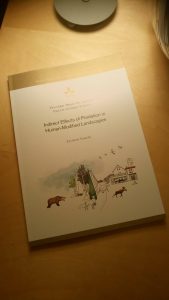 The result of 4 (or more!) years of hard work.
The result of 4 (or more!) years of hard work.
This Friday we attended the doctoral dissertation of Ellinor Sahlén, who’s been studying how animals behave in a landscape altered by humans and what happens when large carnivores return.
Up until now, most studies on the return of large predators have been conducted in North America – or even more precisely, a lot of work has been based around the return of wolves (like 28 million others, you might have seen How Wolves Change Rivers) to Yellowstone national park. But what happens when large predators such as wolves or bears might return to a landscape shaped and changed by mankind? Will their return still yield the same massive changes to the landscape as we’ve seen in North America?
Among other things, Sahlén found that even though some Fallow Deer have never smelt scent from a bear before in their lives, they try to seek out more open areas when they feel there is a risk of being predated so that they can escape quickly. Herbivores also browse differently in these areas, which affects how the herbivores preferred plants grow.
However, in a landscape dominated by human interaction, one might not expect as drastic a change as seen in the pristine Yellowstone national park – in very fragmented habitat or production forest landscapes which are clear-cut every 80 years, the trophic cascades can be relatively minor.
As Sahlin stresses, successful reintroduction of large carnivores is a delicate matter which requires close cooperation with the locals, who should be made aware of how their lives might change by the presence of a large carnivore, as sudden or unexpected negative effects can set the arena for decade-long conflicts between conservationists and local inhabitants.